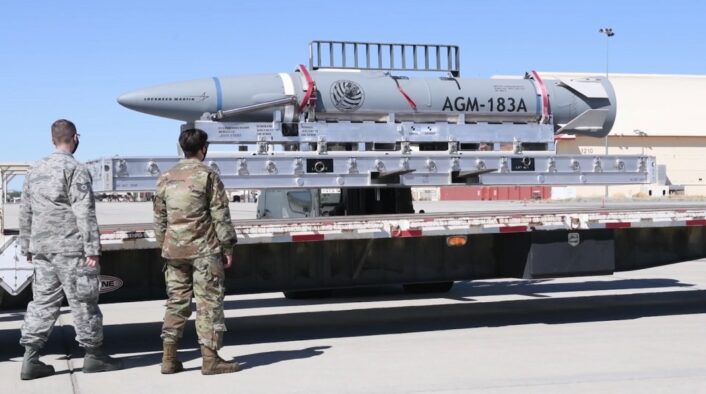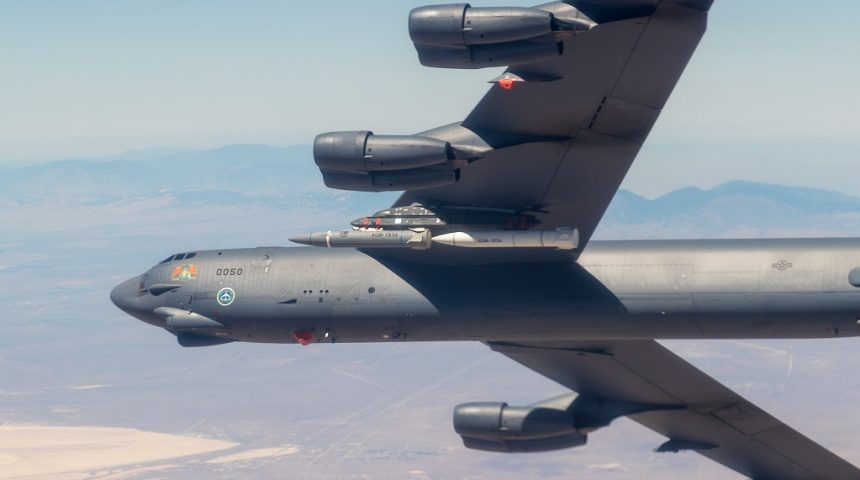The service will complete the two last test flights to inform future hypersonic programs.
The U.S. Air Force is planning to abandon the AGM-183 Air-launched Rapid Response Weapon (ARRW) hypersonic weapon program after the last two test flights of the prototyping phase and focus instead on the Hypersonic Attack Cruise Missile (HACM). The decision apparently was influenced by the latest test flight of the missile, which ended with another failure.
Air Force Assistant Secretary for Acquisition Andrew Hunter told the House Tactical Air and Land Forces Subcommittee in a written testimony on March 29, 2023, that “while the Air Force does not currently intend to pursue follow-on procurement of ARRW once the prototyping program concludes, there is inherent benefit to completing the all-up round test flights to garner the learning and test data that will help inform future hypersonic programs”.
The plans for the acquisition of the AGM-183 were already removed from the Fiscal Year 2022 spending approved by the Congress, with the funds being redirected to additional research and development. The same happened in the FY 2023 request, with funds for $46.6 million to buy only one AGM-183A missile throughout the year. In order to complete the prototyping phase, the Air Force requested $150.3 million of Research, Development, Test, and Evaluation (RDT&E) funding as part of the FY 2024 presidential budget.
The latest test was performed on March 13, 2023, when a B-52H Stratofortress released the second All-Up-Round AGM-183A ARRW off the southern California coast. This test was the second launch of a full prototype operational hypersonic missile and focused on the ARRW’s end-to-end performance. The Air Force initially said in the press release that “the test met several of the objectives and the ARRW team engineers and testers are collecting data for further analysis.”
However, on March 28, Air Force Secretary Frank Kendall told the House Appropriations Committee’s defense panel that the test had, in fact, failed. “The one we just had was not a success. We did not get the data that we needed,” said Kendall while talking about the March 13 test. Last year, Kendall said that the missile still needed to prove itself.
The AGM-183 already ran into issues when Lockheed Martin began testing in 2019. The missile suffered a number of failures when the Air Force started its testing too, with three failed launches in 2021, however it reversed course in 2022 with three successful tests. Among the 2022 tests was the first launch of the fully operational prototype missile, which was defined as a very successful flight.

The AGM-183A ARRW is based on hypersonic glide vehicle technology derived from the Air Force and Defense Advanced Research Projects Agency (DARPA) Science and Technology (S&T) Demonstration known as Tactical Boost Glide (TBG). A fragmenting glide vehicle is launched from a conventional rocket, or more precisely a Solid-Rocket Motor (SRM) booster, to the upper atmosphere and, once it reaches hypersonic speeds, it separates from the rocket and glides to its target at speeds up to Mach 15. At these speeds, there is no need for a conventional explosive warhead as the kinetic energy alone delivered during impact would be enough to destroy most targets.
The Air Force also defined the ARRW as an “operational hypersonic air-launched weapon enabling the U.S. to hold fixed, high value, time-sensitive targets at risk in contested environments from standoff distances.” The missile would have provided a survivable, lethal, long-range strike capability to go after high-end capabilities of a potential adversary, such as deep-inland strike against targets of strategic importance and coastal strike against high-end systems. Initially, the expected introduction in service of the AGM-183 was planned for 2022.
With ARRW being abandoned, the focus is now shifting to the Hypersonic Attack Cruise Missile program which is expected to become operational in 2027. The Air Force awarded Raytheon a contract in 2022 to demonstrate prototypes of the air-launched, scramjet-powered hypersonic weapon designed to hold high-value targets at risk in contested environments from standoff distances.
Raytheon and Northrop Grumman already worked together for the Defense Advanced Research Projects Agency’s Hypersonic Air-breathing Weapon Concept (HAWC), with two successful missile launches in 2021 and 2022. The two companies will now use the lessons learned from HAWC to help the development of HACM.
The system was initially developed in the Southern Cross Integrated Flight Research Experiment, or SCIFiRE, a cooperative program with Australia to design and test hypersonic missile prototypes. Leveraging Northrop Grumman’s scramjet technologies, Raytheon is developing a missile smaller than ARRW which will be integrated on fighter jets. “HACM will provide our commanders with tactical flexibility to employ fighters to hold high-value, time-sensitive targets at risk while maintaining bombers for other strategic targets,” said Air Force Chief of Staff Gen. CQ Brown.









